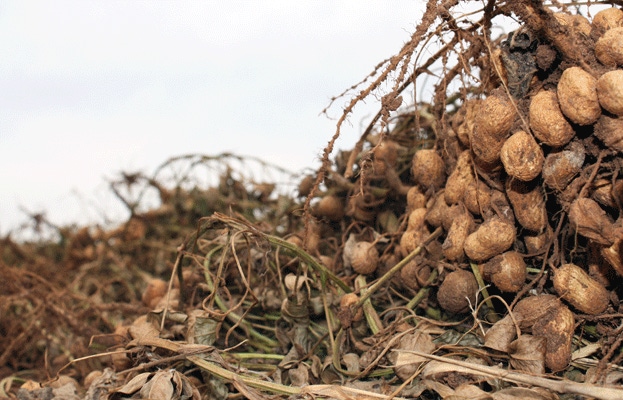December 1, 2014

The U.S. peanut market continues to wrestle against large production numbers from 2012, as producers wrap up harvesting this year’s crop, says John Michael Riley, Mississippi State University Extension economist.
“The U.S. continues to chew on a large production number from 2012,” said Riley at this year’s Southern Region Outlook Conference in Atlanta. “We definitely cut back on the number of acres in 2013. And while we do have a buildup of stocks that we’re trying to work through, we actually saw an increase in acres this past year. So despite a lower yield in 2014, production could be about where it was last year.”
By the first week of November, nearly 80 percent of the 2014 U.S. peanut crop had been harvested.
In late October, 55 percent of the peanut crop was reported in good to excellent condition, about seven percentage points below the same time last year.
Georgia continues to be the “China” of the peanut industry in the United States, says Riley, holding the lion’s share of the acreage, with Alabama and Florida holding the No. 2 and No. 3 positions in terms of total acreage and production.
Total U.S. peanut production for 2014 is forecast at 5.04 billion pounds, up 1 percent from the
October forecast and up 21 percent from last year. Area for harvest is expected to total 1.31 million acres, unchanged from October but 25 percent higher than in 2013.
Based on conditions as of Nov. 1, the average yield for the United States is forecast at 3,860 pounds per acre, up 48 pounds from the October forecast but 141 pounds below the 2013 average yield of 4,001 pounds per acre. Record-high yields are still expected in Florida, North Carolina and Oklahoma.
Perfect storm in 2012
U.S. peanut yield obviously is trending up, says Riley. “And it was a perfect storm in 2012 because not only did we pick up acres, but we also saw a tremendous shift to higher yields. All of this pushed up the production number to the point of being detrimental from a price standpoint.
“We have started to trend down in total acres, probably having to do with the fact that some of those acres that were pulled out were probably low production acres, and that has brought the yield back down some. Still, we’re nowhere near where we were when we first saw that increase.
Back in 2012, there was only one state – New Mexico – that didn’t see an increase in yield. Most states saw significant increases in yield,” he says.
Most of the peanuts in the U.S. are consumed through food consumption, notes Riley. Exports have grown in recent years, and about 500 billion pounds of peanuts are crushed.
“Looking at use versus consumption, obviously that large jump in production in 2012 brought with it a large increase in consumption. If you have a commodity with a limited shelf life, you’ve got to do something with it. So often when you see big jumps in production, it’s often offset on the consumption side of the ledger,” he says.
Export friends
Even though the bulk of peanut consumption goes to food use, exports stepped up and took the brunt of the 2012 production load, says Riley.
“We were able to find some friends overseas, including China, and get some peanuts off the books that way. We are moving back towards more of a historical balance with peanut consumption as we see the number of exports decrease and the number of peanuts being used for food use pick back up to more typical levels.”
Stocks began picking up in 2012, and they’re still lingering, says Riley. And from 2011 on, the price of peanuts has been on the decline.
“We had a huge increase in price coming out of the 2011 growing season, and there was a large market response with a lot of acres going into peanut production. Since then, peanut prices have trended down, currently to just under $400 per ton. Also, the stocks-to-use ration continues to drag in terms of trying to do something with this carryover from one year to the next.”
Moving forward, the market is starting to stabilize to some degree, says Riley, but it doesn’t look as though it’s going to improve significantly anytime soon.
Current USDA price projections looking at the remainder of 2014 and into 2015 are at about $403.37 to $413 per ton, he says.
“We’re still working to reduce a carryover, but despite that, U.S. producers increased acreage in 2014. Was that increase policy-driven or market-driven? We’ve got a reference price for the life of this farm bill of $535 per ton for peanuts. Right now, the USDA projected price is $347 to $413. So even if it does hit the high end of the USDA price projection, you’re still well below this reference price. That’s why this debate was taking place in March and continuing into June about whether or not the jump in acreage in 2014 was market-driven given what we saw at the time in terms of price, or whether it was a policy-driven response. That will continue to be a debate.
“If you look at the Olympic-average price, it is $517 per ton, and moving forward, that price probably will be a flash-in-the-pan. It’ll be interesting to see how the reference price translates into acreage as we move forward.”
About the Author(s)
You May Also Like




